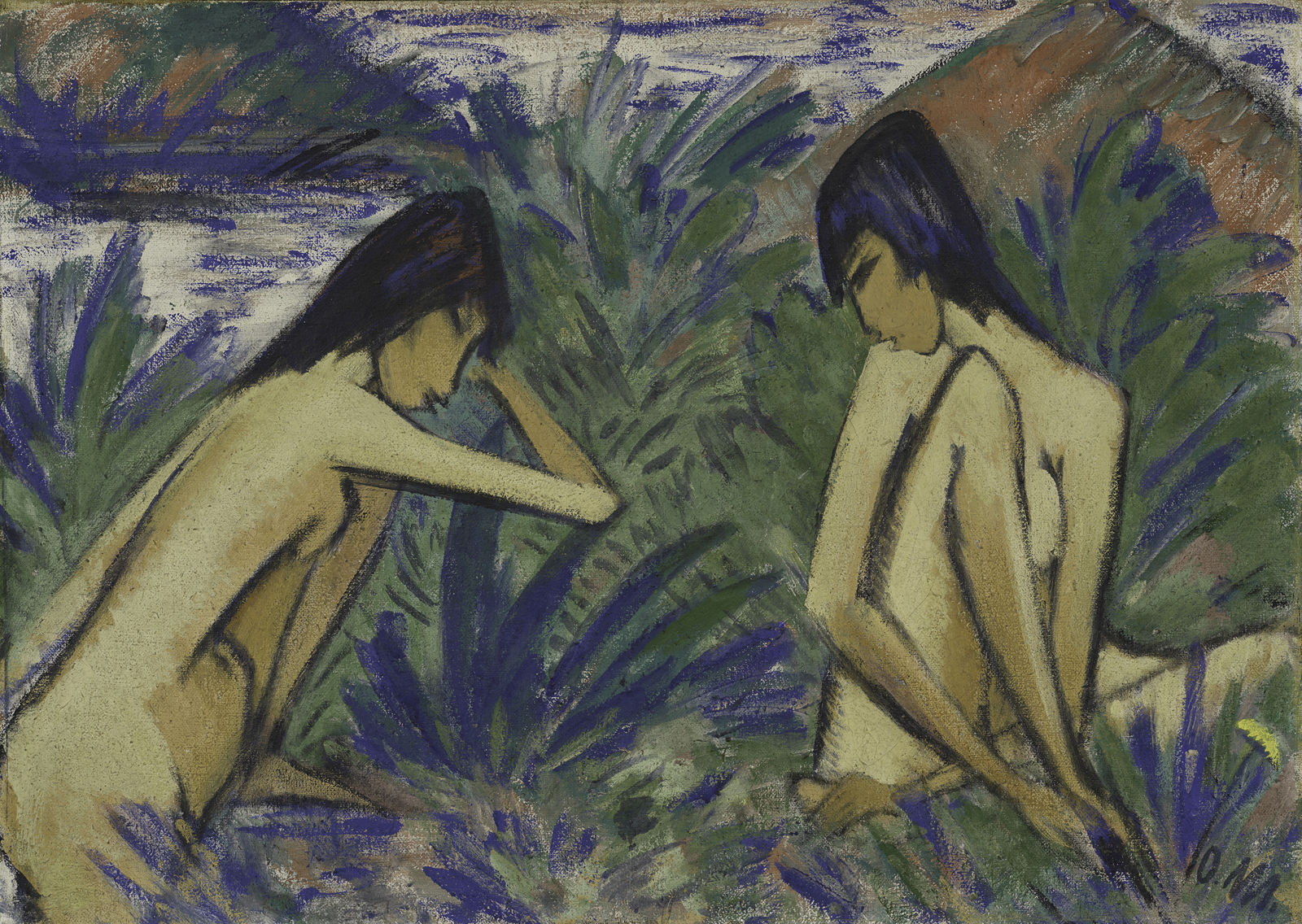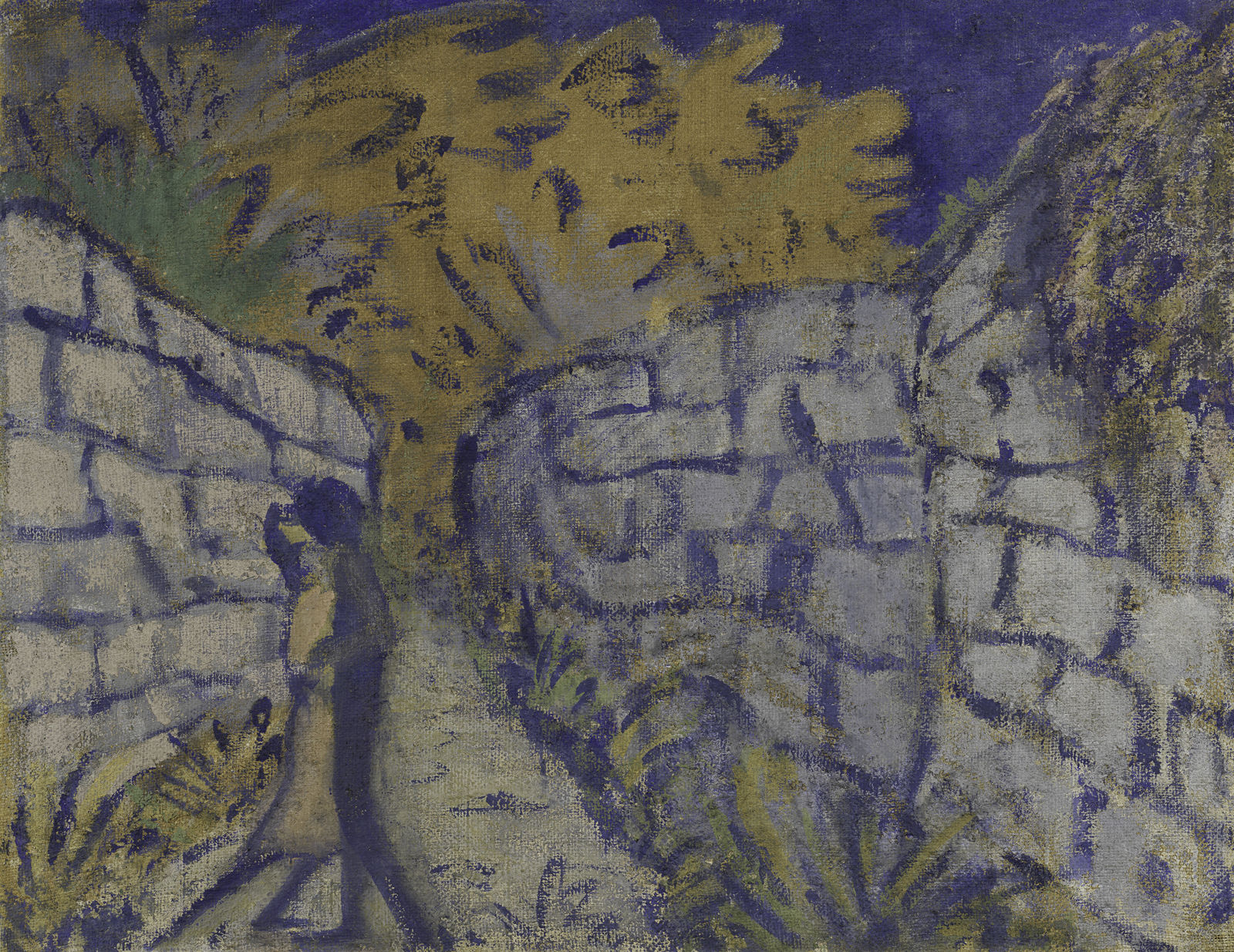Artist
Otto Mueller
Born
16 October 1874, Liebau, Silesia
(today Lubawka, Poland)
Died
24 September 1930, Obernigk, Silesia
(today Oborniki Śląskie, Poland)
Biography
A (circuitous) route to art (1874–1893)
Otto Mueller, the son of lieutenant and revenue officer Julian Mueller and his wife Marie Maywald, grew up as the second of seven children on the edge of the Riesengebirge mountains (now the Krkonoše in the Czech Republic). He spent his youth in Görlitz, where he completed a training course in lithography after attending grammar school from 1891 to 1894. He spent a lot of time with the writers Ivo and Gerhard Hauptmann, his adoptive uncle, who introduced him to intellectual circles.
Art studies (1894–1898)
From 1894 to 1896, Mueller studied at the Royal Academy of Fine Arts in Dresden, where he came into contact with plein air painting and learned to produce studies of nature. In 1898, he wanted to continue his studies at the Academy of Art in Munich, but failed in his attempt to get accepted into the painting class of the Symbolist artist Franz Stuck and instead spent the following two years pursuing self-study in Munich.
Positioning as an artist and meeting Maschka (1898–1908)
In 1899, he moved back to Dresden, where he met Maschka Mayerhofer, his later wife. She was to be his most important model and an intellectual companion at the same time. She was also the inspiration for the characteristically angular facial features that his figures acquired from then on. The couple divided their time between Dresden and various places in the Riesengebirge, during which time Mueller worked intensively on developing his own artistic idiom.
Berlin and the Brücke group (1908–1919)
In 1908, Mueller moved to Berlin. He was able to gain an initial foothold in the Berlin art and culture scene via the literary circle of the S. Fischer Verlag publishing house, and one year later he held his first solo exhibition at the Kunstsalon Gurlitt and also took part in the spring exhibition of the Berlin Secession. In 1910, he joined the artists of the Brücke in contributing works to the exhibition for artists rejected by the Berlin Secession, and he became a member of the group that same year. “The sensory harmony between his life and the work made Mueller a natural member of the Brücke,” wrote Ernst Ludwig Kirchner in the Chronicle of the Brücke in 1913. In contrast to the intensive colour tones that characterized the group’s style at that time, Mueller used pale, earthy tones. He also used distemper on hessian, a technique that was appreciated but never adopted by the other members of the group, whose styles tended towards two-dimensionality and a preference for nudes in landscapes. He developed a close friendship with Kirchner and Erich Heckel in particular, and it continued even after the group disbanded in 1913. From 1914, he was involved with the Free Secession association of artists, and in December 1915 he designed the entrance area of the Secession building on Berlin’s Kurfürstendamm with wall paintings, tapestries on nettle, and sculptures. Unlike his artist colleagues, Mueller was not conscripted for military service until 1916, two years after the start of the First World War. As a non-combatant equipment serviceman, stationed initially in the Flemish town of Namur and later in France, he was not actually on the battle front, but rather worked on the construction and maintenance of fortifications. In 1918, he was posted as a draughtsman to the airship aviation department in Berlin.
Breslau Academy of Art (1919–1930)
In April 1919, Mueller took a professorship at the State Academy of Art and Applied Art in Breslau. During the last 11 years of his life, he taught here alongside other progressive minds such as the painter Oskar Moll, the architect Hans Scharoun, and Bauhaus artist Oskar Schlemmer. Due to his unconventional teaching methods, his anti-bourgeois lifestyle, and his companionable manner with his students, Mueller was loved and respected as a teacher. Nevertheless, he never felt quite at home there: “It’s miserable here in Breslau with the endless rainy weather and ringing of the bells; I’ll go mad sooner or later,” he wrote to Maschka in 1923. And when he was forbidden from living in his studio, he railed against the “old philistines”. Maschka did not follow Mueller to Breslau, and they separated in 1919, eventually divorcing two years later. By 1919 he was already becoming romantically involved with his student Irene Altmann, but the relationship didn’t last because her father forbade her from marrying a man who was not Jewish. Mueller’s subsequent marriage to Elsbeth Lübke, also a student at the Breslau Academy, was likewise short-lived, lasting only from 1922 to 1927, despite her giving birth to their son Josef in 1925. Shortly after the separation, Mueller entered into a relationship with Elfriede Timm, whom he had met at an Academy event.
Travel to Eastern Europe (1924–1930)
From 1924 onwards, Mueller took long trips to various south-eastern European countries, where he studied the culture of the Sinti and the Roma respectively. He idealized their supposedly liberal lifestyle, which he believed reflected his own ideals. He captured his impressions from his trips in a number of photographs and sketches, which he later developed into paintings and lithographs.
Otto Mueller died in September 1930, shortly after marrying Elfriede Timm, in the Obernigk Sanatorium near Breslau as a result of a chronic lung condition.
Isabel Fischer
Bibliography
Maler. Mentor. Magier. Otto Mueller und sein Netzwerk in Breslau, exhib. cat. Neue Galerie im Hamburger Bahnhof – Museum für Gegenwart – Berlin / Muzeum Narodowe we Wroclawiu, eds. Dagmar Schmengler, Agnes Kern & Lidia Gluchowska, (Heidelberg & Berlin: Kehrer Verlag, 2018).
Christiane Remm, Otto Mueller, exhib. cat. Brücke-Museum, Berlin, ed. Magdalena M. Moeller, (Munich: Hirmer Verlag, 2014).
Otto Mueller. Eine Retrospektive, exhib. cat. Kunsthalle der Hypo-Kulturstiftung, Munich, eds. Johann Georg Prinz von Hohenzollern & Mario-Andreas von Lüttichau, (Munich, et al.: Prestel Verlag, 2003).
Lothar-Günther Buchheim, Otto Mueller. Leben und Werk, (Feldafing: Buchheim Verlag, 1963).





